category: Limet-Filling pattern
stitches used: Rose stitches
longitudinal axis: withdrawn thread line
one pattern segment = 16 threads
straight striped pattern
New: At the end of this article are instructions for left-handers.
First, establish a Limet grid with a withdrawn thread line as the longitudinal axis by cutting 1, leaving 3, vertically and horizontally.
Bring the needle up in the hole that is one up from the bottom hole on the longitudinal axis (point where the needle emerges = center of the stitch), and pull the thread through.
Work a Rose stitch. That means: Loop the thread up and to the left, cross over one square (three threads) to the left, insert the needle and bring it up in the center again. Tighten thread.
Loop the thread to the right and up, cross over one square (three threads) up, insert the needle and bring it up in the center hole again. Notice that the looped thread is beneath the needle. Tighten thread.
Loop the thread to the bottom and right, cross over one square (three threads) to the right, insert the needle and bring it up in the center again with the thread beneath the needle. Tighten thread.
Loop the thread to the left and down, cross over one square at the bottom, insert the needle and bring it up in the center again with the looped thread beneath the needle. Tighten thread.
After working the fourth stitch, the working thread comes up to the right of the fourth stitch. Cross over the fourth stitch to the left and insert the needle at the bottom of the center hole.
Bring the needle up in the next center, two squares (six threads) up. (Each second hole of the longitudinal axis is a center of a Rose stitch.)
Start working with the first step of the Rose stitch again.
In this way, one by one, the Rose stitch is worked in a straight row.
The next row is worked staggered one square. So, after inserting the needle at the bottom of the last center hole, bring the needle up in the next center, one square (three threads) up and two squares (six threads) to the left. (Each second hole of this vertical withdrawn-thread line is a center of a Rose stitch.) Turn the piece 180° and work Rose stitches in the established way.
Always alternate working both rows until the entire shape is filled.
Boiled, starched, and ironed this pattern develops a nice soft, fine, and airy structure. The striped character is hardly noticeable.
Instructions for the left-hander:
Bring the needle up in the hole that is one up from the bottom hole on the longitudinal axis (point where the needle emerges = center of the stitch), and pull the thread through. Work a Rose stitch. That means: Loop the thread up and to the right, cross over one square (three threads) to the right, insert the needle and bring it up in the center again. Tighten thread.
Loop the thread to the left and up, cross over one square (three threads) up, insert the needle and bring it up in the center hole again. Notice that the looped thread is beneath the needle. Tighten thread.
Loop the thread to the bottom and left, cross over one square (three threads) to the left, insert the needle and bring it up in the center again with the thread beneath the needle. Tighten thread.
Loop the thread to the right and down, cross over one square at the bottom, insert the needle and bring it up in the center again with the looped thread beneath the needle. Tighten thread.
After working the fourth stitch, the working thread comes up to the left of the fourth stitch. Cross over the fourth stitch to the right and insert the needle at the bottom of the center hole.
Bring the needle up in the next center, two squares (six threads) up. (Each second hole of the longitudinal axis is a center of a Rose stitch.)
Start working with the first step of the Rose stitch again.
In this way, one by one, the Rose stitch is worked in a straight row.
The next row is worked staggered one square. So, after inserting the needle at the bottom of the last center hole, bring the needle up in the next center, one square (three threads) up and two squares (six threads) to the right. (Each second hole of this vertical withdrawn-thread thread line is a center of a Rose stitch.) Turn the piece 180° and work Rose stitches in the established way.
Always alternate working both rows until the entire shape is filled.
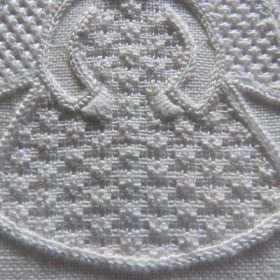
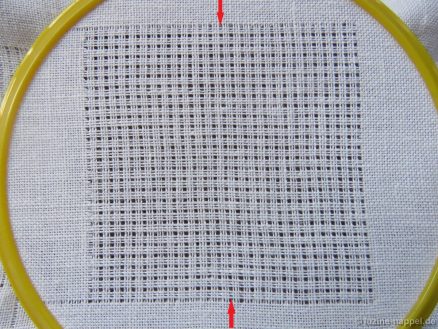

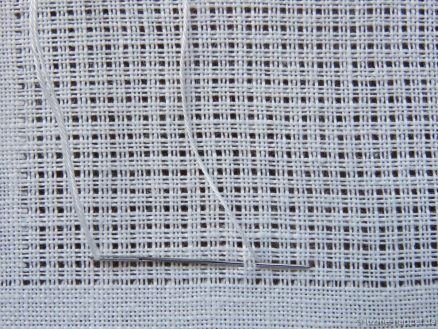
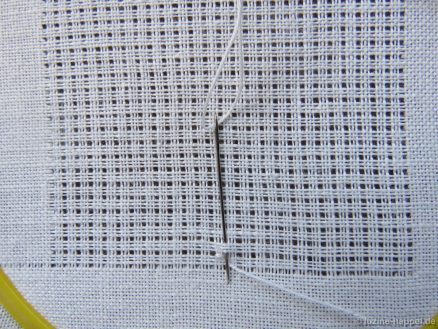




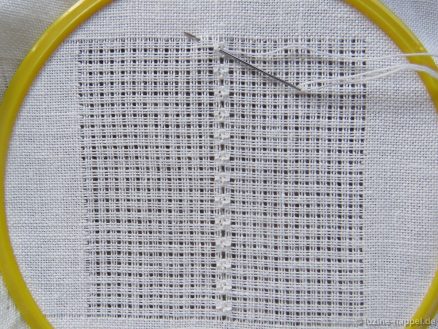








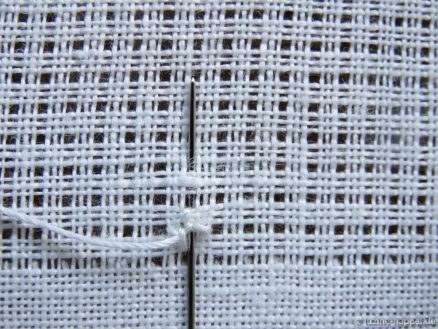


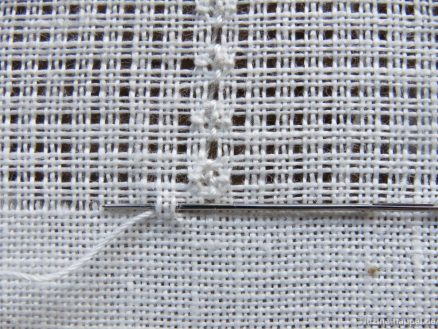



Leave a Reply